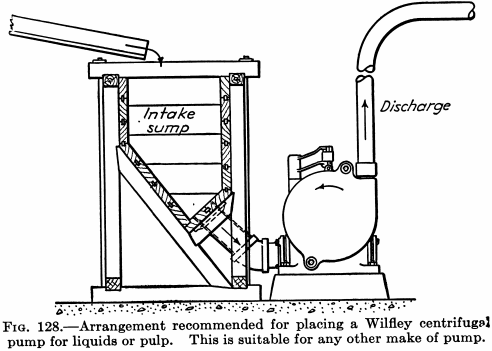The disposal of mill residues or tailings costs 2 to 6 cents pel ton, however carefully it is done. Residues may be moist sand which can be conveyed by belt or trucked to a dump, moist solid slime which can be handled somewhat similarly, or pulp which can be pumped to a suitable place. The handling of sand and slime does not call for any special comment. With rails, a dump

may be extended outward or it may be circular, the latter method being preferable. Pumps suitable for pulp have already been described. Pulp should be dammed in a dump made of the drained material. As the solids settle (a little lime or cement added to the pulp helps) and more or less clear water flows to one point for discharge to waste or for re-use in the mill, walls of the slime are built up with a good batter. If they are too steep, they might collapse. On some well-made dumps, every shovelful of slime can be seen up the side of the walls. The author has seen such dumps containing 10,000 to 2 million tons.
A tailings pile should not become the dumping ground for all the discarded equipment, ash, cans, useless lumber, trees, shrubs, and other waste, because some day it might be profitable to treat the old residue and such trash not only would render “mining” difficult but would cause difficulties in treatment.

Fig. 129.—Dorrco pumps. (A.) Two sizes of diaphragm pumps for low lifts of pump as from a thickener to an agitator. (B) Two sizes of pressure pumps for lifting water, solutions, and pulp where desired. The pulleys may be on either side and the drive shafts’ rotation in either direction.
Dumps should not be too close to a mill because of possible additions to it and because of the dust nuisance; neither should they be built in a ravine or gulley which can be washed out by heavy rain and thus possibly cover ground held by others below.
As legislation against stream pollution becomes more wide-spread, particularly in agricultural and horticultural regions and where the water is used for domestic and stock purposes, the dumping of residues has to be done carefully, especially if solutions of cyanide and flotation reagents are used in treating ores.
